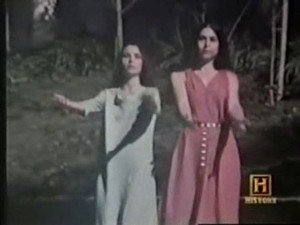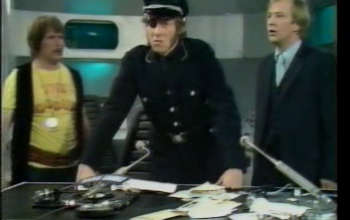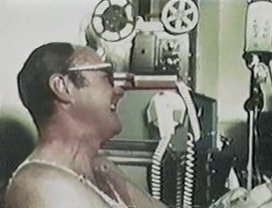In Search Of… S01E08 The Mummy’s Curse
Now we’re talking! Fakey-Egyptian music, check! White women in diaphanous nighties, check! “Legend says…” check. “Coincidence… or curse?” Check, check, check! All right, now we’re cooking with gas! Mummy’s curse FTW!

We begin with a weird anecdote about a play, designed to remove a curse on the Pharaoh Akhenaten. We’ll get back to it later, but for now suffice it to say: it’s odd.
Next up, Egypt! Old! Monuments! Stuff! But we’re not up to this bit yet. We’re going to Highclare Castle, now best known as the location of Downton Abbey. In reality, it is the former home of the Earls of Carnarvon, which I guess means this episode will mostly be about King Tut. We actually interview the 6th Earl, son of the famous 5th Earl of Carnarvon. The old guy actually gestures with his pipe while he’s talking. It’s adorable. The 6th Earl explains that his father was advised by his doctor to travel somewhere warm and dry, and the 5th Earl chose Egypt. Another aristocrat advised him that he’d be bored in Egypt unless he had a hobby like Egyptology, and from there he became Howard Carter’s patron.
Carter was a former British government employee in Egypt, who was searching for antiquities in the Valley of the Kings. With the help of Carnarvon’s money, Carter found Tutankhamun’s tomb. The 6th Earl continues narrating the story, this time with a cigar in one hand and a glass of scotch in the other. (Did I mention I love this guy? I bet Carson handed him his things, just before the cameras started rolling.) He tells how Carter telegraphed Carnarvon to come, and held off opening the tomb until he arrived. They broke the seals, acquired the artefacts and found the body of the boy king.
Now, if this were a legit documentary on Tutankhamun, we’d have to be at least half to two thirds through by now. Or, it would be a great break point on a two part documentary. But it’s In Search Of… and one of the greatest single archaeological finds ever is only prelude to the real story. Nimoy tells of a missing tablet, carrying a warning. Dun dun dahhh!
We get some actual facts about Tut, recited over some quite nice footage of treasures from his tomb. The factual stuff is mixed with the odd piece of trivia about Egypt trading with Minoa. In 1970s pseudoarcharology Minoa usually meant ‘Atlantis’, but this factoid is not really expanded on.
Lord Carnarvon returned to Cairo with some of the artefacts, but contracted fever from a mosquito bite. There’s one of those lovely crappy re-enactments, over which is the narration of the 6th Earl. The tone in which he tells the story of seeing his father die is splendidly matter of fact, taking on an emotional tone only when he’s directly quoting the old man’s nurse.
The English aristocracy. You don’t have to like ’em, but you have to admire ’em.
The 6th Earl says that there was a blackout in Cairo that night, and that the local papers blamed Carnarvon, citing a curse. Brief interlude of Nimoy standing in a graveyard, claiming that the death of Carvarvon was the first of many deaths. Back to the 6th Earl, he explains that returned home, where his dog Suzie died. His telling of this story is quite melodramatic. I wish that the 6th Earl had made spoken word recordings of classic horror stories, because that would be awesome.
Next up is a list of notable people who died after being involved in some way with the tomb. Nimoy says that some of the antiquities were studied in Oxford, which is true. He says this was in order to examine the claim of a curse, which seems less likely. There’s an interview with a historian from the Ashmolean Museum.
No wait. Let me watch that intro again.
There’s an interview with Henry Lincoln a ‘historian’ who is a ‘frequent visitor’ of the Ashmolean. Almost got me there, In Search Of! Almost! Lincoln’s not an academic historian at all, nor even a respected amateur historian but a pseudohistorian. He is best known for Dan Brown cribbing his theory about Jesus for the Da Vinci Code.
Lincoln makes the interesting point that Carvnarvon sold the rights to the story of the tomb’s discovery to the Times, so the other papers needed the curse so they could write about the story obliquely. But, he says, this does not mean that there was no curse. He goes on to talk about Akhenaten, a pharaoh who sought to overthrow Egyptian polytheism in favour of a monotheistic worship of Aten, the sun. Basically, the priests waited until he died then reinstated the old religion. Lincoln also claims that the priests of Amun cursed Akhenaten to walk the Earth forever, and were not altogether keen on Akhenaten’s young successor, Tutankhamun.
Lincoln claims an American artist/hieroglyph copyist Joseph Lynden Smith attempted to lift this curse by putting on a play, and we’re back to where we were to begin with. Re-enactment time! Or is is a re-enactment if it’s a re-enactment of a play? Maybe it’s just an enactment? Or an act, I guess?
Anyway, we’re back to the two women from the beginning, reciting the words of the play, lots of reverb and visual fuzz to make it look interesting. It’s all very arty, but it reminds me of nothing so much as the old TV show The Secret of Isis. Lincoln claims that there was a hailstorm at the dress rehersal, and claims that the Egyptian ‘helpers’ thought that ‘the gods were throwing stones at them’.
Most Modern Egyptians are Muslims or else Coptic or Orthodox Christians. I suspect few, if any, saw the hand of Amun in the weather.
Anyway, apparently both actresses had the same dream that night, involving being attacked in a temple. One dreamed that she was struck in the body, and soon needed an abdominal operation. The other dreamed she was struck in the face, and almost lost her sight to glaucoma. All other people involved had minor illnesses.
“Was that,” Lincoln intones, “the curse of the priests of Amun?”
He gives quite a good reading of the line. But then, unlike many historians, he did get his training at RADA.
Back to Nimoy, and an incident in 1976. The mummy of Rameses was shipped to Paris for preservation work. Then he mentions that Tutankhamun was badly preserved, and some believe this was deliberate on the part of the priests. Then, next sentence, we’re back to Rameses. Perhaps Ramses’ mummy is being attacked by long dormant bacteria. The priests might have known more than we can imagine. Maybe the vessels in Tut’s tomb contained ‘something lethal’?
Okay. I see where they’re going with this. Perhaps the ‘curse’ was something nasty excavated with the body. Something unlikely, but within the realm of science — a poison or a dormant germ. Trouble is, how does that fit in with the Akhenaten play story? Did this chemical cause a hail? Did it kill the 6th Earl’s dog? I’m not even trying to be sceptical here, I’m genuinely just confused as to what point is being made.
Moving on to 1977, and the famous Treasures of Tutakhamun traveling exhibition across the USA. Take it Steve Martin:
Thank you. Nimoy rambles a little, and makes what I consider the ultimate argument against the curse of Tut: Howard Carter lived to a ripe old age. He points out that if the priests did try to destroy the memory of Arkehathen, they failed. We look at some cool burial treasure, and that’s pretty cool. Nimoy claims that if the Tut curse is real then ultimately Tutankhamen succeeded where the priests of Amun failed. Well, that’s so nice for the young man.
Aesthetically, the interesting aspect of this episode is the way the two main voices work – Nimoy, deep, smooth, American, bringing that effortless feeling of intelligence to whatever he’s saying, no matter how nonsensical. This is intercut with the voice of the 6th Earl – aging, English, quavering a little but full of a confidence that most of us can barely imagine, talking about bizarre curses and the deaths of loved ones in the same tone he might have addressed the House of Lords. It’s like the future and the past singing alternate verses of the same song. It’s a little disappointing when the Earl is sidelined in favour of Lincoln, though Lincoln is a skilled storyteller in his own right. All in all, this episode is worth watching just for the narrators and some cool pictures of Egyptian treasures.
And what of the curse? Well, like I said, Howard Carter survived, when he should have been the first one in the curse’s sights. Even in the 1920s when the papers were full of the curse, sensible heads in the media pointed out that quite a lot of the people who supposedly died after seeing/being near the excavation sight were elderly people traveling for their health. “Go somewhere warm and dry” was not just Carnarvon’s prescription, it was pretty common medical advice.
The Akhenaten play is interesting, but in the 1970s there was also a stage play about Akhenaten by Agatha Christie which was performed widely and doesn’t seem to have attracted any hailstorms. If there’s a curse, it’s a sneaky one, in that it curses people in such a way as could be explained by random chance. Since this would defeat the deterrent purpose of such a curse, I think at the very least we can say that the ancient priests didn’t really think things through.
Best line
Not to Nimoy this time. This week’s best line goes to the 6th Earl of Carnarvon:
“So Papa said to himself, ‘Well that’s a fine kettle of fish’, he liked shooting and everything else, so he decided that he’d go off at the end of the shooting season, beginning of February, and he went to Egypt.”
Summing up
Awesome guests: 9/10, Baffling position: 8/10, Crappy reenactments that remind me of favorite childhood TV shows: 9/10, Failure to understand difference between Modern and Ancient Egyptians: 8/10, Nimoyness: 9/10. Overall: 43/50, High Distinction




Trying to take the fun out of a cool old show I enjoyed growing up with…check!
It’s a show I enjoyed growing up with too, and I still enjoy it very much today. That doesn’t mean I don’t have issues with it.
Nimoy (and reality) debunk the “bacteria” theory. It’s self evident that a bacteria isn’t killing people, because it would impact everyone who went into the tomb.
I like this one less than you do. Just found Henry Lincoln to rival Hans Holzer on the dullness scale.
Sidenote: I was a kid in the 70’s, and we actually were in Chicago when the “Treasures of Tutankhamen” exhibit was there, and got to see it. It was fantastic. When they showed scenes from the exhibit, I could remember it vividly.
Hey – maybe I’m cursed!? I blame Tutankhamen from my modest weight gain over the last 4 decades! (Sounds better than me liking to eat fatty foods).
Yeah the bacteria theory… so many of the ‘realistic’ explanations for these sorts of things come across as less plausible than just saying ‘magic!’
Seriously jealous that you saw the Tutankhamen exhibition! Must have been amazing. There’s something about seeing things like that up close. Photos never really do justice.